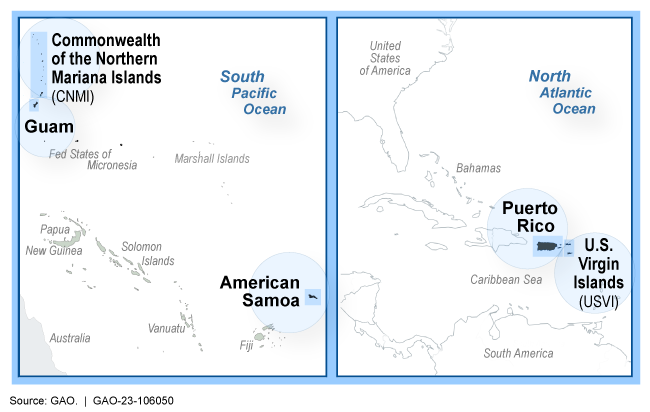COVID-19: U.S. Territory Experiences Could Inform Future Federal Relief
Fast Facts
U.S. territories—American Samoa, the Commonwealth of the Northern Mariana Islands, Guam, Puerto Rico, and the U.S. Virgin Islands—received more than $32 billion in COVID-19 relief funds through over 100 programs.
Territory government officials said they funded key priorities, but some programs were easier to use than others because:
Territory governments already knew how to administer and report on pre-existing programs
Some agencies provided more support and technical assistance than others
Some program flexibilities in how funds can be used helped territories meet their needs
Some funding was immediately available rather than reimbursed
Maps of the U.S. Territories

Highlights
What GAO Found
Federal agencies allocated more than $32 billion in COVID-19 relief funding to the five permanently inhabited U.S. territories—American Samoa, the Commonwealth of the Northern Mariana Islands, Guam, Puerto Rico, and the U.S. Virgin Islands. This relief funding was provided through more than 100 new and existing federal programs across 16 federal agencies. Territory government officials told GAO that this funding helped them meet key priorities, including the public health response to COVID-19, improvements to health care infrastructure and access, replacement of lost revenue for continued government operations, and infrastructure development.
COVID-19 Relief Funding Allocated to U.S. Territory Governments as of May 2023
|
Total allocations (in billions) |
|
|---|---|
|
American Samoa |
$1.3 |
|
Commonwealth of the Northern Mariana Islands |
$1.9 |
|
Guam |
$2.7 |
|
Puerto Rico |
$24.8 |
|
U.S. Virgin Islands |
$1.5 |
|
Total |
$32.1 |
Source: GAO analysis of appropriation and federal agency allocation data. | GAO-23-106050
Notes: Total allocations include COVID-19 relief funding for which U.S. territory government agencies were the recipient. Allocation data were collected between May 2022 and May 2023, prior to the rescission of unobligated funds in a number of COVID-19 relief programs under the Fiscal Responsibility Act of 2023 in June 2023. See Pub. L. No. 118-5, div. B, tit. I, 137 Stat. 10, 23-30 (2023). Allocations do not sum to total due to rounding. COVID-19 relief funding awarded directly to local governments is not included.
Territory government officials told us they faced challenges administering selected COVID-19 relief programs. These included having sufficient administrative capacity, determining allowable uses for funding, spending funds within allotted time frames, and managing reporting requirements.
Based on the experiences of the territorial governments administering COVID-19 relief funding and federal agency actions to mitigate certain challenges, GAO identified four themes that could inform future federal relief to U.S. territories:
- Leveraging pre-existing programs. In contrast to newly created programs, territory officials reported experiencing fewer challenges administering and reporting on pre-existing federal programs that received additional funding.
- Technical assistance. Territory officials faced fewer challenges implementing programs where there was strong coordination and communication between the federal agency and the territory regarding program requirements and reporting.
- Funding flexibilities. Territory governments used COVID-19 relief funding with flexible or broad allowable uses to meet needs that might not be allowable under other federal programs, and worked with federal agencies to modify allowable uses and funding time frames to meet territory needs.
- Immediately available funding. Territory officials said funding that was immediately available, rather than provided as reimbursement, enabled them to better plan, schedule, and expend funds for allowable uses.
Why GAO Did This Study
The federal government has provided more than $4 trillion to help the nation respond to and recover from the COVID-19 pandemic. A portion of those funds went to U.S. territories through various federal programs.
The CARES Act includes a provision for GAO to conduct monitoring and oversight related to the COVID-19 pandemic. This report examines (1) how much funding was allocated to the territories and how territories reported those funds were used; (2) territories' experiences administering COVID-19 relief funding; and (3) how selected federal agencies helped territories administer the funding and what themes can inform future federal relief to the territories.
GAO reviewed the six COVID-19 relief laws enacted in 2020 and 2021, federal agency allocation data, and spending data from USAspending.gov. GAO reviewed program documentation, reports to federal agencies on the use of funds, and applicable Office of Inspector General reports. GAO also interviewed federal and territory agency officials about selected COVID-19 relief programs. These selected programs were those that (1) were implemented by federal agencies that administered the largest COVID-19 relief programs for Tribes, states, localities, and territories; and (2) allocated more than $100 million to the U.S. territories.
For more information, contact Jeff Arkin at (202) 512-6806 or arkinj@gao.gov.
